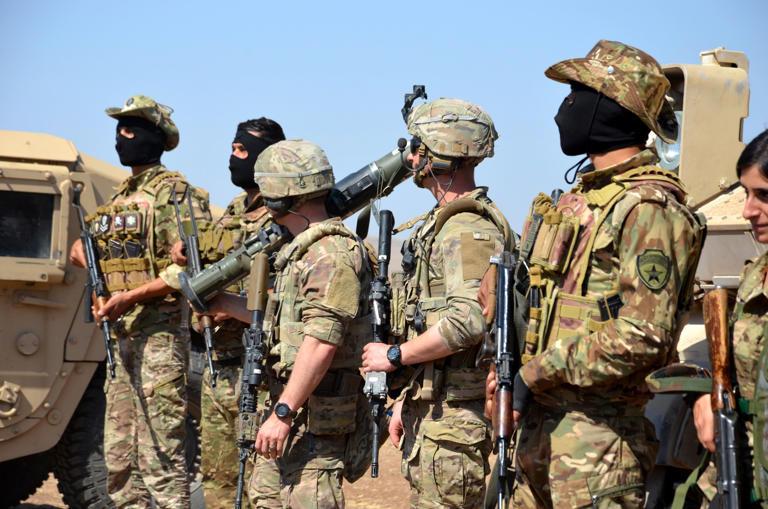
Where does ISIS have a presence now
ISIS has suffered significant blows over the past five years and the terrorist group’s threat remains low in the Middle East yet is growing in sub-Saharan Africa, experts told The National on Thursday.
The staying power of the group was in the spotlight when US Secretary of State Antony Blinken attended a meeting of the Global Coalition to Defeat ISIS, a cohort of 80 countries, in Riyadh on Thursday.
Sub-Saharan Africa has emerged as the global epicentre of terrorism as the region has accounted for nearly 50 per cent of terrorism deaths, according to the 2022 Global Terrorism Index.
ISIS’s expansion in sub-Saharan Africa is a bigger concern than in the Middle East, Aymenn Al Timimi, an expert on terrorism and fellow at the Middle East Forum, told The National.
The main concern is “the group is either exercising some territorial control – Sahel region and parts of Lake Chad area – or simply growing in lethality as an insurgent force – in eastern areas of Democratic Republic of Congo,” Mr Al Timimi said.
US Secretary of State Antony Blinken on Thursday said the war against ISIS was not over, during his visit to Saudi Arabia.
His comments came at a meeting of the Global Coalition to Defeat ISIS, which has focused its efforts on preventing a resurgence of the terrorist group in Iraq, Syria and sub-Saharan Africa.
“Poor security and humanitarian conditions. Lack of economic opportunity. These are the fuel for the kind of desperation on which ISIS feeds and recruits,” he said in brief remarks at the opening of the conference.
“So we have to stay committed to our stabilisation goals.”
Although victory was declared against the group in Iraq and Syria in 2019 – putting an end to the group’s peak financial and military reach – security authorities across the region are wrestling with the legacy of ISIS.
Iraq
ISIS maintained a steady stream of attacks in Iraq that have mostly targeted security forces and army officials since its near-total demise in the aftermath of the battle of Mosul, its last urban stronghold in Iraq.
But the number of attacks pales in comparison to their peak, when ISIS had the capacity to launch hundreds of attacks in Iraq each month. Now, according to California-based Iraq expert Joel Wing, ISIS is at its “lowest level ever in Iraq” and can sustain only several attacks a week.
But the continuing violence suggests the group still has a hold in some parts of Iraq and its threats are looming, Saad Al Obaidi, a security analyst and former Iraqi military official, told The National.
“ISIS has not been able to meet its strategic goals in Iraq and neighbouring Syria so it will continue until it reaches those aims,” Mr Al Obaidi said.
Additionally, regional states “do not have the capability to counter, control and deal with threats from the militant group to be able to defeat it”, he said.
Iraq’s central government has “made many mistakes when attempting to counter their threat, that’s another reason why they [ISIS] would pose a danger”.
For Mr Al Timimi, ISIS operations in Iraq “are essentially at an all-time low because the pressure has been effectively kept on them”.
In the past few months, the US military said it has observed a significant reduction in the number of ISIS attacks compared to previous years.
“We assess this is due to the increased operations by our partners,” said a statement by Centcom, the US military’s headquarters in the Middle East.
Syria
The battle against ISIS is bearing fruit in some areas of Syria, while others continue to contain the group’s activities. Head of the US-led anti-ISIS mission, Maj Gen Matthew McFarlane, said this Ramadan was “one of the most peaceful in years” with an 80 per cent year-on-year drop in attacks in areas the US and the Syrian Democratic Forces administers.
ISIS has conducted attacks against prisons that hold some its most notable fighters in the area controlled by US-backed Kurdish Democratic Forces.
“In parts of Syria the group is more active, for in the central desert regions, but it is still low intensity,” Mr Al Timimi said.
In central and southern Syria the group has expanded its reach, according to the Counter Extremism Project. In regime-held areas the group had its deadliest month in three years, launching 38 attacks in Deir Ezzor, Homs, Hama and Raqqa. In April, at least 71 civilians were killed by ISIS and another seven were kidnapped.
More than 3,000 ISIS fighters have been repatriated from Syria to Iraq and many tried for their crimes, the Iraqi Foreign Ministry said on Thursday. But Al Hol camp for ISIS members and their families remains bursting at the seams, inhabited by more than 50,000. Of those 11,000 are foreign citizens from about 60 countries whose governments have so far refused to repatriate them.
Africa
The Sahel region has proven to be a particular hotspot for the terrorists.
In Nigeria, ISIS re-established control over its renegade Boko Haram branch in the spring of 2021 and fought the Nigerian government to a standstill, retaining control of much territory in the north.
In Mali, Niger and Burkina Faso, ISIS’s presence is not as strong as it is in competition with other militant groups.
In sub-Saharan Africa – Somalia, the Democratic Republic of Congo and Mozambique – ISIS has established footholds and continues expanding them.
ISIS’s main focus for advertising their operations is in Africa, mostly in sub-Saharan Africa, Mr Al Timimi said.
“They are probably underreporting in parts of Iraq and Syria for reasons of operational security but there can be no doubt that Africa is their main focus in the propaganda, in terms of conveying a message of ‘remaining and expanding’,” he said.
Source » msn





